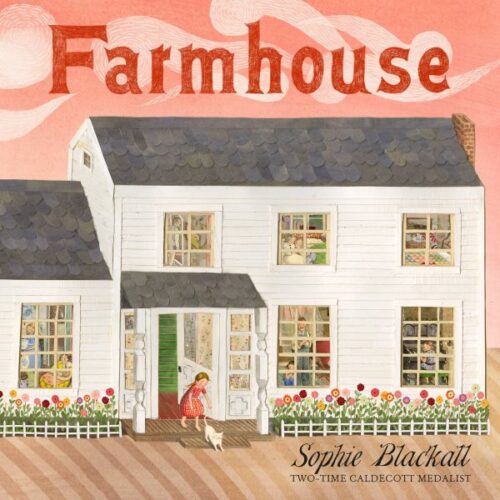Review of the Day: Farmhouse by Sophie Blackall

Farmhouse
By Sophie Blackall
Little, Brown and Company
$18.99
ISBN: 9780316538948
Ages 4-8
On shelves September 13th
The role of a physical home in a child’s life has provided fodder for thousands and thousands of picture books over the years. There are those that are speculative, wondering what it would be like to live somewhere fantastical (like in Molly on the Moon). Some compare one type of home to another (Mirror by Jeannie Baker). For kids with housing security, they may identify keenly with those structures that have housed them. So much so that there are ample picture books about the process of moving from one home to another (my personal favorite being Bad Bye, Good Bye by Deborah Underwood). And some books consider the life of the physical structure of a home itself. The most classic example of this is probably The Little House by Virginia Lee Burton. In that book you don’t see much of the family that lived in the house, but you do see its slow decomposition over the years and the encroaching urbanization. That is, until the happy ending where it’s taken away, fixed up, and given a new lease on life (odds are that encroaching urbanization is gonna start all over again, tho). Farmhouse by Sophie Blackall probably owes some of its existence to Burton’s classic title, though the heart of this book isn’t walls or floors or windows but the people that lived alongside them. Speculation yields a carefully, even meticulously rendered story of an average white farm family, living life in a home, until time takes its toll and we all have to wrestle with what that means.
Go down to the end of a road and you’ll find a farmhouse where twelve children live. We watch them as they do their chores and get in trouble for painting the family cat. We see their dreams, and watch the seasons change. By the end, though, everyone grows up. Even the baby, no longer young, who leaves the house last of all, goes to the sea with her sister. The house’s door opens and in comes nature to take charge of everything inside. Everything, that is, until Sophie Blackall arrives and finds the house in its dilapidated state. So she takes things and cuts things and writes this book to remember the children that once lived here and the lives these walls once saw. An Author’s Note at the end talks about the real house that Sophie bought and the treasures of the past she found both inside and outside.
ADVERTISEMENT
ADVERTISEMENT
As a child, I was fascinated by old places. I’d poke around my grandmothers’ homes, in search of family secrets or treasure. For me, the past left its echoes everywhere. Every physical object could tell some kind of a story. I don’t think I’m wrong in thinking that I would have adored Farmhouse. I think much of that love would have been wrapped up in Blackall’s meticulous attention to detail. You see, my favorite picture book growing up was A Time to Keep by Tasha Tudor, and there are more than a few similarities between this book and that one. In both cases you follow a family in the past through the seasons. You see all these details about the home that they live and grow up in. The difference may lie a lot in the characterizations. These kids all have very different personalities. Personalities that kind of culminate in this fantastic moment near the end where you see a photograph of all twelve of them and can match them to glimpses of the occupations they held later in life. I know for a fact that I would have spent inordinate amounts of time pairing each kid to their future self (and Blackall makes this a bit easier by offering visual clues, like the girl holding the kitten growing up to be a vet, for instance).
Reading this book, though, you start to think about how kids attach emotionally to the physical structures that they inhabit. So it’s just wild to me that Sophie chooses not to end the book, as all these other books have, with the house’s final restitution. You don’t see the final destruction (much, I’m sure, to the chagrin of bulldozer loving kids everywhere) and that’s smart, but that still means that you leave the house in its dilapidated state. This is such an interesting choice. How easily Sophie could have gone the route seen in books like Ray’s The House of Grass and Sky and ended with some crowd pleasing denouement where the house is brought back to life. It seems to me that both tonally and thematically, this book has much more in common with the Julie Fogliano/Lane Smith collaboration on A House That Once Was. In both cases you’ve a house abandoned to the elements, containing traces of the family that once lived there. In both cases that family is not coming back, and the narrator speculates on who they might have been and what their lives were like long ago.
For months before this book was published I took great pleasure in watching Sophie Blackall put the art together physically on Instagram. In many ways, this book feels like a dollhouse for professional illustrators. Years and years ago I visited the studio in Brooklyn that Sophie shared with a number of other artists, and in the corner was a little mini studio with models. I think at the time there was some hope that Sophie would do a book with models as illustrations, ala Red Nose Studio, but nothing ever came of it. Or maybe I shouldn’t say that, since this book is as close as one can come to paper as models. It almost has a paper doll-like quality to it. If you find those old videos, you can watch as Sophie puts together the attic bedroom that many of the children share. It’s the physicality of the enterprise that really comes through to the reader. There’s a kind of POP to the art. We know that all art on a page is two-dimensional. This book just gives an extra added layer of depth to the proceedings. Notice too that you don’t get that feel with the landscape scenes. This dimensionality is completely centered on the house itself. So cool.
I always feel a little bad when I’m reviewing an author/illustrator and I hold off until the very end of the review to mention that they’re a helluva writer as well. It’s tricky. There’s a perception that any old joe schmoe can write a picture book, but that it takes true talent to illustrate one. But even the best artist in the world can only salvage poor writing to a certain extent. And there is NO guarantee that an illustrator is going to be skilled with the written word. I know plenty of Caldecott Award and Honor winners that have written and illustrated perfectly decent, perfectly meh books. Farmhouse hasn’t even the barest whiff of “meh” about it, though. I mean, talk about an opening sentence: “Over a hill, at the end of a road, by a glittering stream that twists and turns, stands a house.” From there we meet the family, come to love them, and then there’s a kind of vertigo that takes place when you go from one two-page spread where the youngest baby has a disease with spots, to that baby now an old woman, saying goodbye to the house for the last time. We watch the home disintegrate and this isn’t treated as a bad thing. It’s seen as natural, in its way. The only crime would be to forget, and so the book gets a little meta on us. We see Sophie herself working on this book, because homes aren’t immortal. But books? If they’re read and remembered, they’ll last longer. As she says in the last sentence, the kids will, “live on, now, in this book that you hold, like your stories will, so long as they’re told.”
Maybe that’s the thing about this book I like so much. Picture books about old houses or old cars or other old structures view natural decomposition as something to be fought and fixed. Farmhouse respectfully disagrees. The tragedy at work here is that the stories that took place in this house might not get told again. They might fade in the memories of the people who knew them. So rather than refurbish and restore the house, Sophie refurbish and restores the family and their lives in book form. And maybe there will be a child that reads this book and begins to wonder about old photographs in their own homes. Maybe they’ll ask for stories about their own ancestors and, if they’re lucky, maybe they’ll hear some they never heard before. We can’t help but wonder about the people who came before us. Isn’t it nice when someone like Sophie Blackall is able to give them a little gift, in appreciation for coming before? A lovely, moving, thoughtful book, full of children, life and death, and the turning of the years.
On shelves September 13th.
Source: Galley sent from publisher for review.
Filed under: Best Books, Best Books of 2022, Reviews, Reviews 2022
About Betsy Bird
Betsy Bird is currently the Collection Development Manager of the Evanston Public Library system and a former Materials Specialist for New York Public Library. She has served on Newbery, written for Horn Book, and has done other lovely little things that she'd love to tell you about but that she's sure you'd find more interesting to hear of in person. Her opinions are her own and do not reflect those of EPL, SLJ, or any of the other acronyms you might be able to name. Follow her on Twitter: @fuseeight.
ADVERTISEMENT
ADVERTISEMENT
SLJ Blog Network
Should I make it holographic? Let’s make it holographic: a JUST ONE WAVE preorder gift for you
Magda, Intergalactic Chef: The Big Tournament | Exclusive Preview
Fifteen early Mock Newbery 2026 Contenders
When Book Bans are a Form of Discrimination, What is the Path to Justice?
Poetry Gateways, a guest post by Amy Brownlee
ADVERTISEMENT







